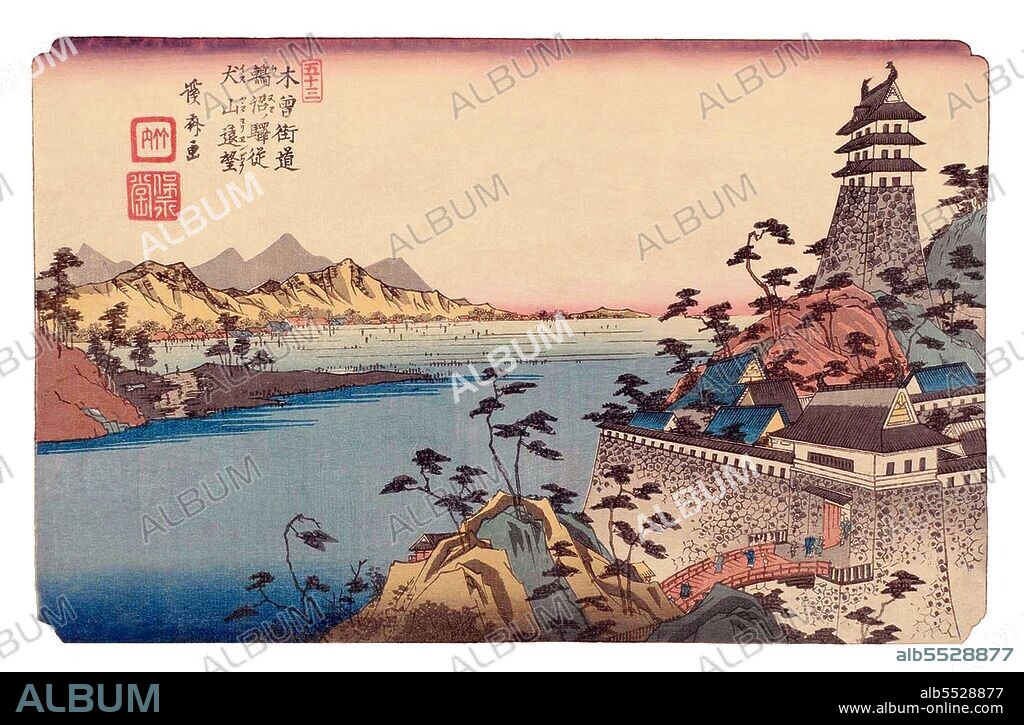alb5528877
Japan: Unuma-juku (???), Station 52 of 'The Sixty-Nine Stations of the Nakasendo (Kisokaido) ' Keisai Eisen (1835-1838)

|
Zu einem anderen Lightbox hinzufügen |
|
Zu einem anderen Lightbox hinzufügen |



Haben Sie bereits ein Konto? Anmelden
Sie haben kein Konto? Registrieren
Dieses Bild kaufen

Titel:
Japan: Unuma-juku (???), Station 52 of 'The Sixty-Nine Stations of the Nakasendo (Kisokaido) ' Keisai Eisen (1835-1838)
Untertitel:
Automatische Übersetzung: Die Neunundsechzig Stationen des Kiso Kaido (????????? Kiso Kaido Rokujukyu-tsugi) oder Neunundsechzig Stationen der Kiso-Straße ist eine Reihe von Ukiyo-e-Werken, die von Utagawa Hiroshige (1797-1858) geschaffen wurden ) und Keisai Eisen (1790-1848). Es gibt insgesamt 71 Drucke in der Serie (einer für jede der 69 Poststationen und Nihonbashi; Nakatsugawa-juku hat zwei Drucke). Der gebräuchliche Name für den Kiso Kaido ist ?Nakasendo? oder ?Central Mountain Highway?, daher wird diese Serie auch allgemein als die 69 Stationen des Nakasendo bezeichnet. Der Nakasendo war eine der fünf Routen, die unter Tokugawa Ieyasu gebaut wurden, eine Reihe von Straßen, die die historische Hauptstadt Edo mit dem Rest Japans verbinden. Der Nakasendo verband Edo mit der damaligen Hauptstadt Kyoto. Es war eine alternative Route zum Tokaido und verlief durch den zentralen Teil von Honshu, was zu seinem Namen führte, der ?zentrale Bergstraße? bedeutet. Entlang dieser Straße gab es neunundsechzig verschiedene Poststationen ( -shuku oder -juku ), die Reisenden Ställe, Verpflegung und Unterkunft boten. Eisen produzierte die ersten 11 Drucke der Serie, von Nihonbashi bis Honjo-shuku, die sich von Tokio bis zur Präfektur Saitama erstreckte. Danach übernahm Hiroshige die Produktion der Serie.
The Sixty-nine Stations of the Kiso Kaido (???????? Kiso Kaido Rokujukyu-tsugi) or Sixty-nine Stations of the Kiso Road, is a series of ukiyo-e works created by Utagawa Hiroshige (1797-1858) and Keisai Eisen (1790-1848). There are 71 total prints in the series (one for each of the 69 post stations and Nihonbashi; Nakatsugawa-juku has two prints). The common name for the Kiso Kaido is 'Nakasendo' or 'Central Mountain Highway', so this series is salso commonly referred to as the Sixty-nine Stations of the Nakasendo. The Nakasendo was one of the Five Routes constructed under Tokugawa Ieyasu, a series of roads linking the historical capitol of Edo with the rest of Japan. The Nakasendo connected Edo with the then-capital of Kyoto. It was an alternate route to the Tokaido and travelled through the central part of Honshu, thus giving rise to its name, which means 'Central Mountain Road'. Along this road, there were sixty-nine different post stations (-shuku or -juku), which provided stables, food, and lodging for travelers. Eisen produced the first 11 prints of the series, from Nihonbashi to Honjo-shuku, stretching from Tokyo to Saitama Prefecture. After that, Hiroshige took over production of the series.
Bildnachweis:
Album / Pictures From History/Universal Images Group
Freigaben (Releases):
Model: Nein - Eigentum: Nein
Rechtefragen?
Rechtefragen?
Bildgröße:
5100 x 3349 px | 48.9 MB
Druckgröße:
43.2 x 28.4 cm | 17.0 x 11.2 in (300 dpi)
Schlüsselwörter:
ANDO HIROSHIGE • ASIEN • ASIEN, KONTINENT • DIPLOMATIE • GEMAELDE • GESCHICHTE • GEWERBE • HIROSHIGE UTAGAWA • HIROSHIGE, ANDO • JAPAN • JAPANER • JAPANERIN • JAPANISCH • KONTINENT, ASIEN • KUNST • MALEREI • ORMNAMENT: JAPANISCH • TRANSPORT • TRANSPORTE • ZEITGESCHICHTE
 Pinterest
Pinterest Twitter
Twitter Facebook
Facebook Link kopieren
Link kopieren Email
Email
